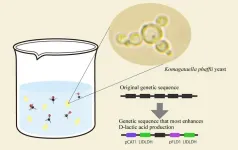(Press-News.org) A drug-resistant type of bacteria that has adapted to health care settings evolved in the past several years to weaponize an antimicrobial genetic tool, eliminating its cousins and replacing them as the dominate strain. University of Pittsburgh School of Medicine scientists made the discovery when combing through local hospital data – and then confirmed that it was a global phenomenon.
The finding, published today in Nature Microbiology, may be the impetus for new approaches in developing therapeutics against some of the world’s deadliest bacteria. It also validates a new use for a system developed at Pitt and UPMC that couples genomic sequencing with computer algorithms to rapidly detect infectious disease outbreaks.
“Our lab has a front row seat to the parade of pathogens that move through the hospital setting,” said senior author Daria Van Tyne, Ph.D., associate professor of medicine in Pitt’s Division of Infectious Diseases. “And when we took a step back and zoomed out, it quickly became apparent that big changes were afoot with one of the world’s more difficult-to-treat bacteria.”
The Enhanced Detection System for Healthcare-Associated Transmission (EDS-HAT) analyzes the genetic signatures of infections in hospitalized patients and flags patterns, allowing clinicians to intervene and stop potential outbreaks in real-time. But lead author Emma Mills, a microbiology and immunology graduate student in Van Tyne’s lab, realized that EDS-HAT was also a treasure trove of detailed historic information that she could mine to learn about the evolution of bacteria over time.
Mills focused on vancomycin-resistant Enterococcus faecium (VREfm), so-called because it can’t be eradicated with the popular antibiotic vancomycin. VREfm kills about 40% of the people it infects and is a particular plague on immunocompromised and hospitalized patients, who are often taking antibiotics that decrease the diversity of bacteria in their microbiomes, allowing drug-resistant bacteria, such as VREfm, to thrive.
After analyzing the genomic sequences of 710 VREfm infection samples from hospitalized patients entered into EDS-HAT over a six-year time span, Mills discovered that the variety of VREfm strains had shrunk from about eight fairly evenly distributed types in 2017 to two dominant strains that began to emerge in 2018 and, by the end of 2022, were the culprit in four out of every five patient VREfm samples.
Upon closer examination, Mills found that the dominant strains had acquired the ability to produce a bacteriocin, which is an antimicrobial that bacteria use to kill or inhibit one another. They’d weaponized this new capability to destroy the other VREfm strains, giving them unfettered access to nutrients for easier reproduction.
This further sparked Mills’s curiosity: If this was happening at the local hospital, was it happening elsewhere? No prior research publications had explored the possibility that this was a global phenomenon, so she consulted a publicly available library of more than 15,000 VREfm genomes collected globally from 2002 through 2022. Sure enough, what she’d observed locally had also been happening on a global scale.
“This was a completely unexpected discovery – I was surprised to see such a dramatic signal,” said Mills. “Once these strains are in an institutional setting – such as a hospital – and are matched up against other strains of VRE in a patient’s gut, they take over. It’s a ‘kill your buddies and eat their food’ scenario.”
Van Tyne said the finding doesn’t have immediate clinical consequences – it does not appear that the bacteriocin-wielding VREfm are making patients any sicker than their predecessors did. But it could point to potential avenues for the development of new therapies.
“The diversity of the VRE population appears to be narrowing from lots of different types causing infection to only a few. That means we may soon have only one single target for which to design therapeutics such as antibiotics or phage therapy,” Van Tyne said. “It also suggests that bacteriocins are very potent and perhaps we could weaponize them for our own purposes.”
Additional authors of the study are Katharine Hewlett, Alexander B. Smith, Ph.D., and Joseph P. Zackular, Ph.D., of Children’s Hospital of Philadelphia; and Marissa P. Griffith, Lora Pless, Ph.D., Alexander J. Sundermann, Dr.P.H., and Lee H. Harrison, M.D., of Pitt.
This research was funded by National Institutes of Health grants R01AI165519, R01AI127472 and R35GM138369.
END
Deadly bacteria developed the ability to produce antimicrobials and wiped-out competitors
2025-03-21
ELSE PRESS RELEASES FROM THIS DATE:
Device enables direct communication among multiple quantum processors
2025-03-21
Quantum computers have the potential to solve complex problems that would be impossible for the most powerful classical supercomputer to crack.
Just like a classical computer has separate, yet interconnected, components that must work together, such as a memory chip and a CPU on a motherboard, a quantum computer will need to communicate quantum information between multiple processors.
Current architectures used to interconnect superconducting quantum processors are “point-to-point” in connectivity, meaning they require a series of transfers between network nodes, with compounding error rates.
On the way ...
Nanotech-induced cooling improves crop yields in arid climates
2025-03-21
Scientists at King Abdullah University of Science and Technology (KAUST) have developed and combined a new nanoplastic and biodegradable mulch to passively cool greenhouses in hot, arid climates like those in the Middle East. Applying their technology, they lowered temperatures of miniature greenhouses by 25 degrees Celsius and increased crop yields of Chinese cabbage by nearly 200%. The study can be read in Nexus.
The nanoplastic consists of polyethylene, the most widely produced plastic in the world, infused with nanoparticles consisting of the molecule cesium tungsten oxide. These nanoparticles absorb ...
Home sweet home: some great hammerhead sharks stick to the perfect neighborhood in the Bahamas instead of migrating
2025-03-21
New research shows that some great hammerhead sharks are homebodies. Scientists studying great hammerheads around Andros in the Bahamas shark sanctuary have found that while some individuals migrate, others prefer to stay at home — potentially because their environment provides them with everything they need. This information could help protect the critically endangered species.
“The global population of great hammerheads is thought to have reduced by more than 80% over the last three generations, and genomic ...
Bubbly idea: Ultrafine bubble showers suppress atopic dermatitis
2025-03-21
Bubble baths might be soothing soaks, but bubble showers could be the next thing in keeping the skin clean.
An Osaka Metropolitan University-led medical research team found that ultrafine bubble showers might help prevent atopic dermatitis.
Graduate School of Medicine student Ayaki Matsumoto and Associate Professor Hisayoshi Imanishi led the study into using ultrafine bubbles, often used to clean medical equipment, on mice with atopic dermatitis.
The scientists found that in mice with atopic dermatitis due to external factors, inflammation was markedly suppressed when the affected skin ...
Aotearoa once home to elephant seals
2025-03-21
Southern elephant seals are the “canary in the coal mine” for the Southern Ocean, offering insight into how the ecosystem may react to future climate change and human impact, new research shows.
Joint senior author Associate Professor Nic Rawlence, Director of the Otago Palaeogenetics Laboratory, says while elephant seals now only inhabit the subantarctic islands and South America, Aotearoa beaches used to be “heaving” with the colossal animals.
“At the time of human arrival in New Zealand, you would be hard pressed to find room on the beaches, with fur seals on the rocky headlands, prehistoric sealions and elephant seals ...
Green recipe: Engineered yeast boosts D-lactic acid production
2025-03-21
Great recipes require the perfect combination of ingredients — biotechnology recipes are no exception.
Researchers from Osaka Metropolitan University have discovered the ideal genetic “recipe” to turn yeast into a tiny yet powerful eco-friendly factory that converts methanol into D-lactic acid, a key compound used in biodegradable plastics and pharmaceuticals. This approach could help reduce reliance on petroleum-based processes and contribute to more sustainable chemical production.
Lactic acid is widely used in food, cosmetics, pharmaceuticals and bioplastics. It exists in two forms: L-lactic acid ...
Computational drug discovery: Exploring natural products targeting SARS-CoV-2
2025-03-21
Ikoma, Japan—The COVID-19 pandemic highlighted the urgent need for effective therapeutic agents against SARS-CoV-2. Although vaccines helped control the spread of the virus, the emergence of new variants continues to challenge global health efforts. Small-molecule inhibitors targeting viral proteins could serve as an effective alternative for controlling the spread of COVID-19 at both individual and community levels.
In this vein, a recent study led by Associate Professor Md. Altaf-Ul-Amin, along with Muhammad Alqaaf, Ahmad Kamal Nasution, Mohammad Bozlul Karim, Mahfujul Islam ...
Almost half of children with complicated appendicitis can recover from surgery at home
2025-03-21
Almost half of children who require surgery for complicated appendicitis can safely complete their recovery at home, according to a new study.
The research, led by Murdoch Children’s Research Institute (MCRI) and published in the Journal of Pediatric Surgery, found more than 40 per cent who received care in the home following a complex appendectomy recovered faster and had fewer complications.
More than 300 patients present with appendicitis to The Royal Children's Hospital (RCH) every year, with about one in three ...
Sensory t-shirt collects patient data and enables shorter postoperative hospital stay
2025-03-21
A t-shirt that monitors a patient’s vitals after urological surgery for cancer could help people return from hospital sooner to recover at home. The device, worn for around two weeks under clothes for three-hour windows each day, enabled patients to feel safer and more reassured than a control group in a pilot study of 70 individuals.
The results are presented this weekend at the European Association of Urology (EAU) Congress in Madrid.
Telemedicine in medical practice allows patients and clinicians to maintain contact remotely so that care, interventions and monitoring ...
Worse outcomes for men who avoid prostate cancer screening
2025-03-21
Men who consistently avoid prostate cancer screening appointments face a disproportionately higher risk of dying from the disease, finds research identifying a new high-risk group.
An analysis of data from across seven countries from the world’s largest prostate cancer screening study, the European Randomized study of Screening for Prostate Cancer (ERSPC), is presented this weekend at the European Association of Urology (EAU) Congress in Madrid.
Prostate cancer is the most common form of cancer in men in 112 countries, with prevalence expected to double by 2040. If introduced on a national scale, prostate ...





